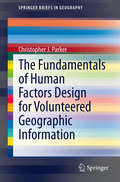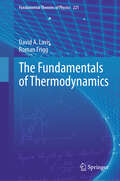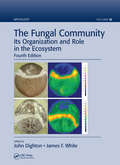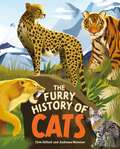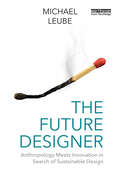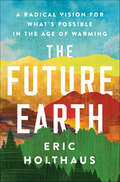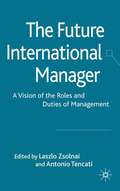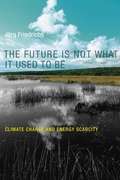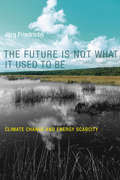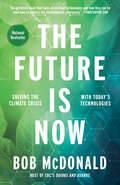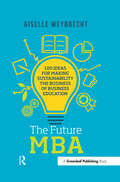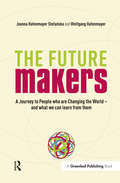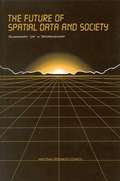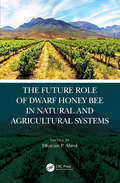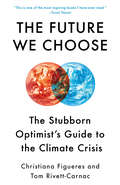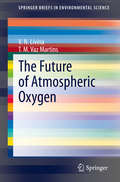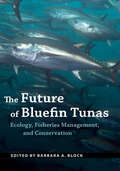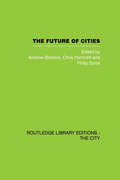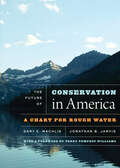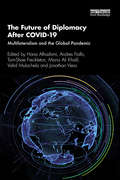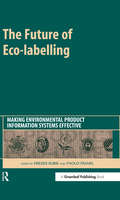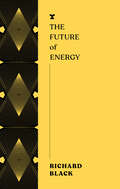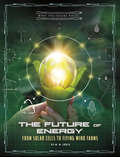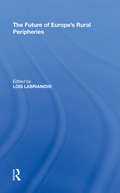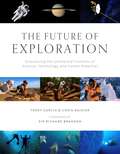- Table View
- List View
The Fundamentals of Human Factors Design for Volunteered Geographic Information
by Christopher J. ParkerThis book explores the roles in which volunteered and professional information play within neogeography from a human factors perspective. The unique advantages of each information type are considered alongside how they may be utilised to create products and services delivering highly functional, efficient and satisfying experiences to their users. The overall aim of this book is to address the issue of how Volunteered Geographic Information (VGI) can be combined with Professional Geographic Information (PGI) to satisfy the information search requirements of consumer-users via highly usable mashups. Firstly, this required the development of an understanding of the way different users perceive VGI and PGI in terms of its benefits to their activities and information needs. Secondly, the benefits that VGI may bring to the user experience of a mashup (which cannot be attained through the use of PGI) needed to be understood. In order to achieve this, a user centred design perspective was implemented throughout the research.
The Fundamentals of Thermodynamics (Fundamental Theories of Physics #221)
by Roman Frigg David A. LavisThe aim of this text is to provide an account of the fundamentals of thermodynamics which is accessible at graduate level to physicists, mathematicians and philosophers of physics. The bulk of the book (Chapters 2-9) is based on the algebraic approach of Lieb and Yngvason, but extended to encompass both positive and negative temperatures and systems in which entropy increases and decreases in adiabatic processes. We show that these four possibilities are already present in Carathéodory's version of the Second Law which arises as a theorem from the axioms. We develop generalized versions of the Kelvin-Planck and Clausius formulations valid for the same range of systems. The parallel development in Chapter 10 takes a geometric approach. We discuss the limitations associated with the local nature of Carathéodory's Principle and present the resolution of this problem due to Boyling. Part of the aim here is to substantiate the claim of Arnold that the mathematical structure of thermodynamics is contact geometry. The last two chapters of the book extend the scope of the discussion to, respectively, critical phenomena and non-equilibrium systems. Chapter 11 is a presentation of phase transitions and critical phenomena in which we discuss universality and use scaling theory to derive scaling laws. Chapter 12 contains a generalization to non-equilibrium. We present the extension of Lieb and Yngvason's work to non-equilibrium and also give a brief account of classical irreversible thermodynamics (CIT). The latter enables a possible understanding of the way that the lack of a unique entropy function in the Lieb and Yngvason non-equilibrium approach can be resolved. The book is completed by a set of appendices which provide mathematical and physical support to the work in the main text.
The Fungal Community: Its Organization and Role in the Ecosystem, Fourth Edition (Mycology)
by James F. White John Dighton"…a number of chapters provide excellent summaries of the modern methods available for studying fungal ecology, along with those more traditional methods that are still extremely valuable…overall it is a hugely valuable compendium of fungal ecology research. It is a must for the library shelf." -Lynne Boddy, Cardiff University, UK, Mycological Research, 2006"These 44 chapters are an excellent starting point for anyone interested in fungal communities, in the broadest sense of the term. It is a book for dipping into…may be the last comprehensive treatment of fungal communities before the molecular revolution."-Meriel Jones, University of Liverpool, UK, Microbiology Today "… the scope of the work is tremendous. … Excellent chapters providing overviews of methods … provide a snap shot of the current approaches used to understand fungal communities at several levels of organization. This book should probably be on the shelf of every student of mycology, and many ecologists too. For all students, this book should be a valuable resource and source of inspiration." -Daniel Henk, Imperial College Faculty of Medicine, London, in Inoculum, Vol. 59, No. 3, May 2008 "Thorough taxonomic and subject indices further aid the reader in navigating through multiple authors’ treatments of subjects of interest." - Anthony Amend, Department of Botany, University of Hawaii at Manoa in Economic Botany, V. 61 In all subjects in science, new findings and the use of new technologies allow us to develop an ever-greater understanding of our world. Expanded and updated coverage in the fourth edition includes: Adds new sections on Integrating Genomics and Metagenomics into Community Analysis, Recent Advances in Fungal Endophyte Research, Fungi in the Built Environment, and Fungal Signaling and Communication Includes a broader treatment of fungal communities in natural ecosystems with in-depth coverage of fungal adaptations to stress and conservation Expands coverage of the influence of climate change on fungi and the role of fungi in organically polluted ecosystems Includes contributions from scientists from 20 nations to illustrate a true global approach for bridging gaps between ecological concepts and mycology
The Furry History of Cats (History of... #2)
by Clive GiffordRoarsome and awesome cats are amongst the most intriguing and much-loved mammals on the planet. With over 40 different species, this book looks at them all, from the smallest, cutest cats to the most powerful cats such as lions, tigers and jaguars.Discover how their fur is important in many different ways. See inside cats to reveal the features that give them their agile movement and hunting prowess. Learn about their paw-fect super senses. Travel back in time to discover the prehistoric sabre-toothed cats. Then discover what you can do to help look after cats at home and in the wild.The colourful and detailed illustrations from Andressa Meissner bring the cats vividly to life. The consultant is the curator of the Big Cat Sanctuary, a UK-based charity established to conserve wild cats globally
The Future Designer: Anthropology Meets Innovation in Search of Sustainable Design
by Michael LeubeDuring periods of environmental and societal upheaval, design has the potential to be a formidable catalyst towards a sustainable future. However, to unleash its full power, significant shifts in both theory and practice are imperative. This book adopts a unique approach, blending anthropological perspectives with philosophy and cognitive science, and advocates for a thorough transformation of the existing design curriculum.Supported by a vast body of literature in evolutionary science and design research, the book presents a blueprint for fostering more sustainable patterns of production and consumption. This blueprint is grounded in human virtues rather than vices and proposes a new curriculum tailored towards pro-sociality and sustainability. Leveraging his extensive professional background and expertise in the circular economy, Michael Leube offers practical examples, methods and tools for implementing sustainable approaches in the practical work of experienced designers. Showcasing cutting-edge innovations for pro-social and humanitarian design, the book ultimately argues that if we change the objective of design from creating desire to creating value, we can solve many of the most pressing social problems, from the cooperation of citizens to sustainable cities.The book will be useful for those studying and teaching design and anthropology, and it will also be an important tool for practicing designers and engineers interested in learning how to design for social and ecological awareness.
The Future Earth: A Radical Vision for What's Possible in the Age of Warming
by Eric HolthausThe first hopeful book about climate change, The Future Earth shows readers how to reverse the short- and long-term effects of climate change over the next three decades.The basics of climate science are easy. We know it is entirely human-caused. Which means its solutions will be similarly human-led. In The Future Earth, leading climate change advocate and weather-related journalist Eric Holthaus (“the Rebel Nerd of Meteorology”—Rolling Stone) offers a radical vision of our future, specifically how to reverse the short- and long-term effects of climate change over the next three decades. Anchored by world-class reporting, interviews with futurists, climatologists, biologists, economists, and climate change activists, it shows what the world could look like if we implemented radical solutions on the scale of the crises we face. What could happen if we reduced carbon emissions by 50 percent in the next decade?What could living in a city look like in 2030?How could the world operate in 2040, if the proposed Green New Deal created a 100 percent net carbon-free economy in the United States?This is the book for anyone who feels overwhelmed by the current state of our environment. Hopeful and prophetic, The Future Earth invites us to imagine how we can reverse the effects of climate change in our own lifetime and encourages us to enter a deeper relationship with the earth as conscientious stewards and to re-affirm our commitment to one another in our shared humanity.
The Future International Manager
by Laszlo Zsolnai Antonio TencatiAn in-depth look at the desired professional profile of new international managers in different aspects of business. It examines the qualities an international manager needs to possess, including commitment to environmental sustainability, sensitivity toward gender and diversity issues and an engagement in progressive entrepreneurship.
The Future Is Not What It Used to Be
by Jörg FriedrichsThe future is not what it used to be because we can no longer rely on the comfortingassumption that it will resemble the past. Past abundance of fuel, for example, does not implyunending abundance. Infinite growth on a finite planet is not possible. In thisbook, Jrg Friedrichs argues that industrial society itself is transitory, and he examines theprospects for our civilization's coming to terms with its two most imminent choke points: climatechange and energy scarcity. He offers a thorough and accessible account of these two challenges aswell as the linkages between them. Friedrichs contends that industrialcivilization cannot outlast our ability to burn fossil fuels and that the demise of industrialsociety would entail cataclysmic change, including population decreases. To understand the socialand political implications, he examines historical cases of climate stress and energy scarcity:devastating droughts in the ancient Near East; the Little Ice Age in the medieval Far North; theJapanese struggle to prevent "fuel starvation" from 1918 to 1945; the "totalitarianretrenchment" of the North Korean governing class after the end of Soviet oil deliveries; andCuba's socioeconomic adaptation to fuel scarcity in the 1990s. He draws important lessons about thelikely effects of climate and energy disruptions on different kinds ofsocieties. The warnings of climate scientists are met by denial and inaction,while energy experts offer little guidance on the effects of future scarcity. Friedrichs suggeststhat to confront our predicament we must affirm our core values and take action to transform our wayof life. Whether we are private citizens or public officials, complacency is not an option: climatechange and energy scarcity are emerging facts of life.
The Future Is Not What It Used to Be: Climate Change and Energy Scarcity
by Jorg FriedrichsA hard look at the twin challenges of climate change and energy scarcity that examines historical precedents and allows no room for complacency.The future is not what it used to be because we can no longer rely on the comforting assumption that it will resemble the past. Past abundance of fuel, for example, does not imply unending abundance. Infinite growth on a finite planet is not possible. In this book, Jörg Friedrichs argues that industrial society itself is transitory, and he examines the prospects for our civilization's coming to terms with its two most imminent choke points: climate change and energy scarcity. He offers a thorough and accessible account of these two challenges as well as the linkages between them.Friedrichs contends that industrial civilization cannot outlast our ability to burn fossil fuels and that the demise of industrial society would entail cataclysmic change, including population decreases. To understand the social and political implications, he examines historical cases of climate stress and energy scarcity: devastating droughts in the ancient Near East; the Little Ice Age in the medieval Far North; the Japanese struggle to prevent “fuel starvation” from 1918 to 1945; the “totalitarian retrenchment” of the North Korean governing class after the end of Soviet oil deliveries; and Cuba's socioeconomic adaptation to fuel scarcity in the 1990s. He draws important lessons about the likely effects of climate and energy disruptions on different kinds of societies.The warnings of climate scientists are met by denial and inaction, while energy experts offer little guidance on the effects of future scarcity. Friedrichs suggests that to confront our predicament we must affirm our core values and take action to transform our way of life. Whether we are private citizens or public officials, complacency is not an option: climate change and energy scarcity are emerging facts of life.
The Future Is Now: Solving the Climate Crisis with Today's Technologies
by Bob McDonaldIs a global pandemic what it took to show us that saving our planet is possible?In the absence of motorized boats and gondolas, Venice&’s waters have returned to a sparkling blue color. Deer have been spotted roaming cities in Italy, and mountain goats recently took over a small seaside town in Wales. Taking advantage of the decreased boat traffic, whales have returned to roaming Vancouver&’s harbours. The absence of &“regular&” human activities has dramatically affected our environment. In this book, Bob McDonald turns his focus to global energy sources, and shows how the global shutdowns may have been exactly what we needed to show us that a greener future is achievable. This is not another &“wake-up call,&” and not another plea to heed the climate science. This is an exploration of the incredible technologies that our species can use to get out of the mess we&’ve made for ourselves. It is a work of immense optimism, to counteract the sense of doom that hangs over most discussions of the environment. Many alternative energy sources such as wind, solar, and geothermal have been available for decades—but they alone will not be enough. Additional power will come from small nuclear reactors the size of an office desk, and space-based solar power satellites with enormous mirrors that can capture sunlight, convert it to microwaves, and beam it to the ground to light up entire cities. Energy will be captured from waves, tides, and hydrogen. Vehicles will no longer have tailpipes that emit smog particles. Food will be sourced locally. Green technology is one of the fastest growing sectors of the economy, and will only continue to skyrocket as current products improve their performance and new products emerge. A new green age is upon us--let this book be your guide to the future.
The Future MBA: 100 Ideas for Making Sustainability the Business of Business Education (The Principles for Responsible Management Education Series)
by Giselle WeybrechtThe Future MBA brings together 100 ideas on how to rethink management education in order to embed sustainability. This book acts as a creative toolkit for individuals working in management education on how to design new and innovative products, services, and experiences for the business school community with a focus on sustainability. What if we took a moment to stand back and look at the bigger picture? What would the business school of the future look like? Rather than a roadmap, the 100 ideas presented in this book are meant to be a source of inspiration in responding to these questions. Some ideas could be put into practice tomorrow, some would require a complete reassessment of the way we view business education, and others are meant to encourage more ideas… and more action, to turn management education into a key player in moving the sustainability agenda forward.
The Future Makers: A Journey to People who are Changing the World – and What We Can Learn from Them
by joanna Hafenmayer wolfgang HafenmayerAre you looking for sense and meaning in your work? Would you like to be successful but expect more in the way of reward and fulfilment than just a paycheque? The Future Makers offers 23 encouraging responses to these questions. It tells the diverse stories of people from around the world who have made a sustainable mark on the world through their careers: from an American financial market specialist to tree planters in Africa; from Japanese environmental experts to dancers in Argentina. The Future Makers are people who make the world a better, more beautiful and livable place for current and coming generations. The Hafenmayers present these inspiring stories in an accessible, entertaining and thoughtful way. But they also do far more. The book presents a toolkit on how you can forge a career that has a positive impact on the world. This step-by-step process has already had a life-changing impact on readers of the original German edition. It is packed with helpful suggestions for personal development and reorientation – for a work life that will make you happier and deeply satisfied. The Future Makers takes you on a journey to people whose values and visions aren't compartmentalized into corners of their lives. They live their dreams every day. This book will show you how you can do the same.
The Future Of Spatial Data And Society: Summary Of A Workshop
by Mapping Science CommitteeA report on The Future Of Spatial Data And Society
The Future Role of Dwarf Honey Bees in Natural and Agricultural Systems
by Dharam P. AbrolThe future role of dwarf honeybees in natural and agricultural systems provides multidisciplinary perspective about the different facets of dwarf honeybees. The role of dwarf honeybee Apis florea assumes utmost importance in the context of pollinator decline throughout the world threatening stability of ecosystems and global food security. Apis florea is a low land species of south Asia extending more to the west than other Asiatic Apis species. It is an important pollinator of crops in hot and dry agricultural plains. The book is first of its kind which deals in details on varied aspects of Apis florea biology, management, conservation strategies for protecting biodiversity and enhancing crop productivity. The book aims to promote a large, diverse, sustainable, and dependable bee pollinator workforce that can meet the challenge for optimizing food production well into the 21st century. Features: Apis florea provides source of livelihood in mountainous areas and marginal farmers. This book will for the first time present the beekeeping from the perspective of agricultural production and biodiversity conservation An excellent source of advanced study material for academics, researchers and students and programme planners Excellent pollinator of tropical and subtropical crops fruits vegetables etc less prone to diseases and enemies Covering the latest information on various aspects of Apis florea biology, this book brings the latest advances together in a single volume for researchers and advanced level students This book will be useful to pollination biologists, honeybee biologists in entomology departments, students, teachers, scientists of agriculture, animal behaviour, botany, conservation, biology, ecology, entomology, environmental biology, forestry, genetics, plant breeding, horticulture, toxicology, zoology, seed growers and seed agencies and shall serve as reference book for students, teachers, researchers, extension functionaries and policy planners.
The Future We Choose: Surviving the Climate Crisis
by Christiana Figueres Tom Rivett-CarnacClimate change: it is arguably the most urgent and consequential issue humankind has ever faced. How we address it in the next thirty years will determine the kind of world we will live in and will bequeath to our children and to theirs.In The Future We Choose, Christiana Figueres and Tom Rivett-Carnac--who led negotiations for the United Nations during the historic Paris Agreement of 2015--have written a cautionary but optimistic book about the world's changing climate and the fate of humanity. The authors outline two possible scenarios for our planet. In one, they describe what life on Earth will be like by 2050 if we fail to meet the Paris climate targets. In the other, they lay out what it will be like to live in a carbon neutral, regenerative world. They argue for confronting the climate crisis head-on, with determination and optimism. The Future We Choose presents our options and tells us what governments, corporations, and each of us can and must do to fend off disaster.
The Future of Atmospheric Oxygen (SpringerBriefs in Environmental Science)
by V. N. Livina T. M. Vaz MartinsThis book investigates various aspects of the phenomenon of atmospheric oxygen depletion, and summarizes our current knowledge of atmospheric oxygen. The authors address the currently available records indicating that atmospheric oxygen is undergoing nonlinear decline. The consensus in the research community is that the main reason for this decline is the combustion of fossil fuels (which is growing nonlinearly). However, the short length of the currently available records, alongside the technological and social uncertainties that may risk speed up oxygen depletion, raise questions about the time scale of the decline, in particular, when oxygen depletion may cause physiological impact on humans and animals. The authors analyze this uncertainty to postulate the near term impact of depleted atmospheric oxygen, and perform multidisciplinary complex modelling of oxygen with long-term horizon estimations.
The Future of Bluefin Tunas: Ecology, Fisheries Management, and Conservation
by Barbara A. BlockThe most thorough and current account of scientific research on bluefin tunas—the largest, most sought-after tunas in the worldBluefin tunas are dominant keystone predators known for their impressive size, strength, endurance, and speed. Electronic tags have revealed that they can dive to great depths (over 6000 feet) and migrate vast distances—from frigid subpolar seas to warm tropical waters—for spawning. Prized for their rich taste and unique texture, bluefin tunas are also a worldwide commodity of great value. However, over the past few decades, overfishing throughout their range has led to significant population reductions.In The Future of Bluefin Tunas, Barbara A. Block brings together renowned bluefin experts from 15 different countries to share the latest information on the science, fisheries policy, and management decisions related to each of the three species within the Thunnus group—Atlantic, Pacific, and Southern. Synthesizing basic and applied research, the book delves into every aspect of these majestic fish, from their life history and genetic makeup to their ecology and migrations. Ichthyologists and marine scientists dedicated to the study of these fishes report on the latest stock assessments, explore the results of advances such as biologging and DNA sampling, and assess the potential of bluefin tuna aquaculture.The Future of Bluefin Tunas provides critical research findings to inform decisions that will impact tunas and the ocean ecosystems they affect. Scientists, fisheries managers, policymakers, and marine conservationists will take away key data from this timely volume to help them ensure these remarkable fish continue in perpetuity.
The Future of Cities
by Chris Hamnett Andrew Blowers Philip SarreThis collection of readings draws on material from a wide range of sources - from the past and present and from literature and technology - and is concentrated on the areas which seem most relevant to the planning of the future city - what is happening to the city and what we can do about it. The readings have been selected and organised to present the planning of the future city. This book was first published in 1974.
The Future of Conservation in America: A Chart For Rough Water, With A Foreword By Terry Tempest Williams
by Terry Tempest Williams Gary E. Machlis Jonathan B. JarvisThis is a turbulent time for the conservation of America’s natural and cultural heritage. From the current assaults on environmental protection to the threats of climate change, biodiversity loss, and disparity of environmental justice, the challenges facing the conservation movement are both immediate and long term. In this time of uncertainty, we need a clear and compelling guide for the future of conservation in America, a declaration to inspire the next generation of conservation leaders. This is that guide—what the authors describe as “a chart for rough water.” Written by the first scientist appointed as science advisor to the director of the National Park Service and the eighteenth director of the National Park Service, this is a candid, passionate, and ultimately hopeful book. The authors describe a unified vision of conservation that binds nature protection, historical preservation, sustainability, public health, civil rights and social justice, and science into common cause—and offer real-world strategies for progress. To be read, pondered, debated, and often revisited, The Future of Conservation in America is destined to be a touchstone for the conservation movement in the decades ahead.
The Future of Diplomacy After COVID-19: Multilateralism and the Global Pandemic
by Hana AlhashimiThis book considers the impact of the COVID-19 pandemic on international diplomacy, and the challenges and opportunities it presents for the future of multilateralism. Global cooperation and solidarity are central to responding to and mitigating the health and socio-economic effects of the COVID-19 pandemic, yet, to many, this was slow to mobilize and lacking in political leadership. This book takes a practical look at the lessons learned from the period spanning the World Health Organization’s first declaration of a public health emergency of international concern in January 2020, to the commemoration of the 75th Anniversary of the United Nations in October 2020. This timespan covers a critical period in which to consider key areas of diplomacy, covering a range of tools of global cooperation: multilateral diplomacy, the rule of law, sustainable development, economics and financing, digital governance, and peace and security. Each chapter in this book introduces readers to the current situation in their respective areas, followed by a constructive consideration of lessons learned from the pandemic’s impact on that field, and key recommendations for the future. The practical focus and future orientation is particularly important as the book injects pragmatism and guidance that will facilitate ‘building back better’ in COVID response plans, while creating space for continued focus on global commitments around sustainable development and the future of the UN. Written by a team of authors who have worked directly in International Public Policy and the establishment of global agendas at the United Nations, this book will be essential reading for professionals and policymakers involved in diplomatic roles, as well as students and scholars interested in the future of international relations, global governance and sustainable development.
The Future of Eco-labelling: Making Environmental Product Information Systems Effective
by Frieder Rubik Paolo FranklEco-labelling is one of the key tools used by policy-makers in many parts of the world to encourage more sustainable production and consumption. By providing environmental information on products and services, eco-labels address both business users and consumers and range from mandatory approaches, such as required product declarations, to voluntary approaches, such as national eco-labels. Eco-labels can play an important role in environmental policy. They reward and promote environmentally superior goods and services and offer information on quality and performance with respect to issues such as health and energy consumption. Eco-labels fit well into a multi-stakeholder policy framework – as promulgated recently by the EU's integrated product policy (IPP) – since the development of criteria for labels and the acceptance in the market requires the involvement of a wide range of different parties, from government and business, to consumers and environmental organisations. However, many eco-labelling schemes have had troubled histories, and questions have been raised about their effectiveness. So, are eco-labels an effective tool to foster the development, production, sale and use of products and to provide consumers with good information about the environmental impacts of those products? Is eco-labelling useful to business as a marketing tool? What factors contribute to the development of successful schemes? More than ten years after its establishment, can the EU Flower be considered a success? Are national eco-labels such as the German Blue Angel and the Norwegian White Swan more effective? Should eco-labels be harmonised? Are eco-labels achieving their original aim of fostering sustainable production and consumption? For which product groups are ISO type I eco-labels appropriate and inappropriate? Are other labels, such as mandatory, ISO type II and ISO type III labels more effective in some cases? Are eco-labels focusing on the main environmental policy targets or just on "low-hanging fruit"? Are eco-labels really linked to other tools of IPP? The Future of Eco-labelling provides answers to all of these questions. Based on a major EU research exercise, the book plots a course for policy-makers to address some of the historic problems with eco-labelling, to learn what works and what doesn't and to move forward with schemes that can make a real difference to sustainable production and consumption.The book analyses the conditions under which eco-labelling schemes-both mandatory and voluntary-are or can become an efficient and effective tool to achieve given objectives; assesses previous experiences with eco-labels in different European countries and the relationship of these schemes with business strategies, IPP and market conditions; defines strategies aimed at linking eco-labels with other IPP measures; explores how eco-labels can be used to encourage sustainable consumption patterns, create green markets, foster innovation and development of green products and services, and implement multi-stakeholder initiatives; and sets out detailed recommendations for the future of eco-labelling.The book will be required reading for policy-makers, businesses involved with eco-labelling schemes and researchers interested in the development of sustainable production and consumption and IPP worldwide.
The Future of Energy (The FUTURES Series)
by Richard BlackHow will the world produce more, cleaner energy? Climate communications expert Richard Black sets out a vision for the future which could benefit us all.Coal, oil and gas provide four-fifths of the energy that powers our modern world. But continuing to burn them will mean wrecking the only planet we have. Is there a way out?In The Future of Energy, journalist and analyst Richard Black argues that there is, and that the transition to a clean energy world is already underway. He shows that with just five key technologies we can replace the burning of fossil fuels almost entirely, as quickly as society decides.Doing so will do much more than halt climate change. The transition will bring cheaper energy, cleaner air, and more jobs. It will remove some of the factors behind oppression, injustice, and conflict. And it is supported by an overwhelming majority of the world&’s population. This may not be the story of energy that you hear most about from politicians, business leaders and journalists, but it is the one that matters.
The Future of Energy: From Solar Cells to Flying Wind Farms (What the Future Holds)
by M. M. EbochOur world runs on energy! But traditional fossil fuels are doing great damage to the environment, and they will eventually run out. How might solar, water, wind and geothermal power come to our rescue? Readers can discover how different the world could look in the future with energy sources that are clean and renewable.
The Future of Europe's Rural Peripheries: Entrepreneurship, Employment Problems And Social Marginalisation (Ashgate Economic Geography Ser.)
by Lois LabrianidisBringing together case studies from Germany, Greece, Poland, Portugal and the UK, this book examines the contribution of entrepreneurial ventures and new technology in stimulating economic development in rural locations. It looks at instances of 'good practice' in terms of both public and private initiatives, and develops a coherent combination of policy objectives facilitating the long-term economic development of the countryside. Firstly analyzing the key causes and effects of economic restructuring currently affecting Europe's rural areas, the book then explores the consequences that European integration and 'globalization' have had and will have in future. It identifies sources of entrepreneurship and examines their distribution between different gender, age and other social groupings. The book continues to evaluate the extent to which the existing institutional, social and technological environment and infrastructure encourages and facilitates entrepreneurship.
The Future of Exploration: Discovering the Uncharted Frontiers of Science, Technology, and Human Potential
by Chris Rainier Terry GarciaAt this very moment, explorers in some of the most remote and dangerous places on earth, from the deepest parts of the ocean, to the highest mountains, and to outer space are enduring unimaginable hardships to expand our knowledge and save what is truly important.Join former National Geographic Executive Vice President and Chief Science Officer Terry Garcia and nature and cultural photographer Chris Rainier, a National Geographic Explorer, on a journey with some of the world&’s most renowned and respected explorers, scientists, astronauts, visionaries, thinkers, and authors as they discuss and share their insights about what motivates them, what is left to explore, and why we should care in The Future of Exploration. Exploration is as old as humankind, but there are still surprises that await us. With technology opening doors that once seemed permanently closed, the twenty-first century will be the greatest age of exploration in our history. Accompanied with awe-inspiring photography, each contributor shares their personal achievements and insight into what the future of exploration looks like from their respective fields, the challenges we face, and possible solutions. Whether delving into the terrestrial, oceanic, or cosmic frontiers, embark on a journey into the uncharted future and be inspired yourself to be a part of the future of exploration.
